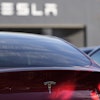
U.S auto safety regulators are investigating complaints that automatic emergency braking can stop for no reason on two Honda models.
It's another in a string of probes by the agency into performance of automatic braking systems, technology that has been touted as having the ability to prevent many crashes and save lives.
The investigation by the National Highway Traffic Safety Administration covers just over 250,000 Insight and Passport models from the 2019 to 2022 model years.
In documents posted on its website Monday, the agency says it received 46 complaints from owners that the system brakes with no apparent obstruction in a vehicle's path, without warning. The complaining owners reported three crashes and two injuries.
The agency says it is investigating to determine the scope and severity of the potential problem, which could increase the risk of a crash.
In a statement, Honda said it is cooperating in the probe and is continuing an internal review. It said the investigation is the agency's first level of inquiry and involves "a limited number of consumer reports of inadvertent activation of the automatic emergency braking system."
Just over two years ago NHTSA opened an investigation into complaints that over 1.7 million Hondas braked without an obstacle in the way. The probe covered two of the company's most popular models, the CR-V and Accord.
NHTSA also opened a probe in 2022 of at least 750 complaints that Tesla models 3 and Y can brake for no reason.
And in May of last year, the agency began investigating Freightliner trucks for similar complaints.
Last May the agency announced it plans to require all new passenger cars and light trucks to include automatic emergency braking within three years. The proposed regulation would set standards to make the systems more effective at higher speeds and better at avoiding pedestrians, especially at night.
The regulation proposed by NHTSA will require, for example, that the systems allow vehicles to fully avoid other vehicles at up to 50 miles per hour if a driver should fail to react. If a driver brakes some but not enough to stop a collision, the system would have to avoid hitting another vehicle at up to 62 mph.
In 2016, the auto industry voluntarily decided to make the systems standard on over 95% of the passenger vehicles they manufacture by Aug. 31 of last year. The Insurance Institute for Highway Safety said all 20 participating automakers met the pledge as of last December.






















